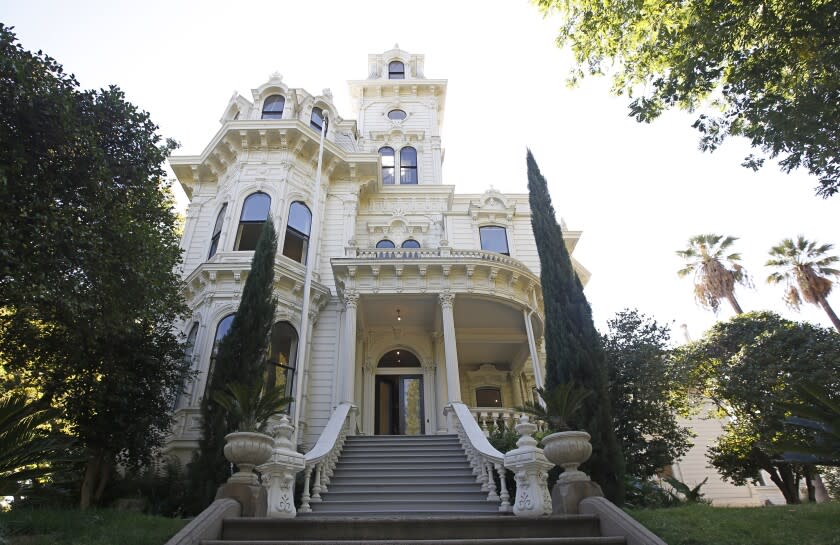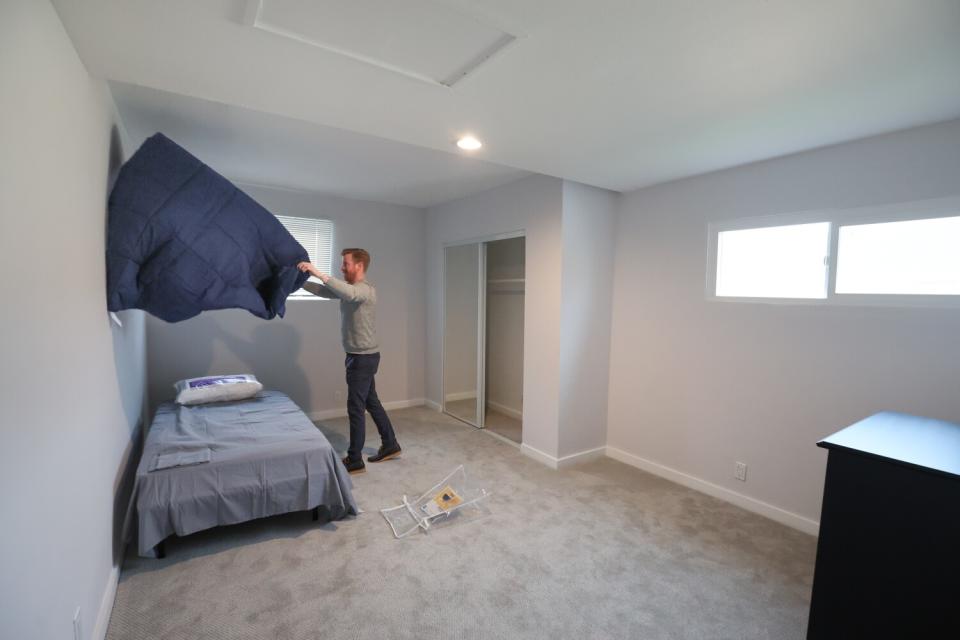Column: Why is the governor's mansion empty while California's homeless crisis gets worse?

- Oops!Something went wrong.Please try again later.
The governor's mansion in Sacramento looks like a good place to shoot a horror movie — looming and empty.
It sits on a busy corner at a nexus of our dual crises of homelessness and unaffordable housing — topped by a turret where Kathleen Brown once tossed water balloons at trick-or-treaters while her father, then-Gov. Pat Brown, was out of town. One of Sacramento’s largest homeless service providers is walking distance away. But the neighborhood is also gentrifying after a decades-long slump. Kitty-corner to the mansion, a 492-square-foot studio is renting for upward of $1,800 a month.
California sends the wrong message by leaving the People’s House empty while rents shoot up and homeless people wander by. The governor isn’t using the place. Should we give it to someone who can?
We are at a unique moment with homelessness. The pandemic, for all its hardship, has generated a slew of federal funds. This year, the state budget is also flush, and Gov. Gavin Newsom is pushing to add billions in spending for shelter, mental health services and cleanups of encampments, urging us to "advance a resourceful mindset" during a Los Angeles news conference Monday. But anger is piling up as quick as the money, and people are tired of hearing the same old same old. We are increasingly skeptical and frustrated — and in need of radical proof that this moment won't be wasted.
I asked the governor's staff for a tour of the mansion, though I didn't mention my idea of offering it to new tenants. They politely rebuffed my requests. So I turned to someone familiar with the property, John Ackerley, a landscaper who said his five years tending the grounds has brought him a lot of pride. Talking to me through the wrought iron fence when I stopped by recently, Ackerley said he thought my idea was terrible. Most people did.
"You know homeless," he said, explaining that it was too important of a historical site to risk its ruin.
Yes, it may seem impractical or problematic to house unsheltered people in the governor's mansion or other empty or underutilized public buildings. Imagine UC Berkeley's Campanile or San Francisco's Palace of Fine Arts turned into temporary shelters. But these are drastic days, and a failure of imagination is one reason California is making only halting progress helping its homeless citizens, estimated at 161,000 as of last year.
Oakland City Councilmember Carroll Fife agreed with Ackerley that "rational people, probably your friends," would say the idea is "pushing it too far." But she's no stranger to pushing. She made headlines not long ago when she and a group of mothers took over an empty corporate-owned house, eventually forcing its sale to a trust that will keep it for homeless families.
If something doesn't give, "potentially taking over the governor's mansion ... all the mansions ... is what we are going to have to do," she said.
It is not as if California is doing nothing to shelter people. Projects Roomkey and Homekey, which quickly moved 58,000 people off the streets and into hotels and motels, show that action can happen when it suits us. But Roomkey wasn't entirely altruistic. It was fueled by fear that coronavirus outbreaks among unsheltered populations could overwhelm care systems, endangering everyone.
The impasse we face now is driven by ambivalence and stigma — who we think "those" people are and where we think they deserve to live. The vast majority of Californians want unsheltered people off the streets so long as their neighborhood isn't affected.
It’s an anxiety I understand. My husband and I own a house in a comfortable Sacramento neighborhood, one that has long fought the idea of a shelter nearby and where there is little affordable housing. But the crisis of homelessness is everywhere. Not long ago, a homeless man hit an 8-year-old boy in the face near the local doughnut shop. My daughters have watched men, presumably homeless, use our lawn as a restroom. We have homeless neighbors sleeping on the sidewalk of the church across the street and in the bushes of the parklet in front of our house. For a while, a gentleman we called Rapper Man would put on nightly music shows at about 3 a.m. They were not kid-friendly.
This house is our financial plan, and we need it and our neighborhood to be safe. But I’ve spent years covering homelessness from every angle, and I can no longer try to remain professionally detached. I believe it’s a moral crisis, that housing is a human right. Every neighborhood and possibly every street will have to be part of the answer, since helping our most vulnerable will ultimately help us all.
Jonathan Russell, who helps run a housing program in the Bay Area that buys single-family homes and rents rooms to those in need, says he hears fears like mine all the time.
"The problem is an economy where middle-income earners, their only hope of an assured retirement, of safety if crisis should befall, is that property," he pointed out. For lucky property owners and renters who feel stable, there's a "profound fear of anything that would risk it."

Fife said even in her famously liberal city, where unsheltered people occupy nearly every freeway ramp and underpass, housed residents show up at city meetings swearing they want equitable solutions, "but the outcomes don't necessarily match the rhetoric." It's hours of people explaining why they are all for progress, just not whatever particular plan is being discussed.
California is increasingly using its stick to pressure local governments to approve affordable housing and homeless plans. But for local elected officials, there is a political calculus. Voters from less enfranchised areas will fume if services and shelters are forced into their neighborhoods, but they often don't show up at meetings. Certain neighborhoods bear the brunt of hosting homeless facilities over and over because, for elected leaders, they are easier to deal with.
Those realities have created something of a homeless industrial complex. Every project has to count because it's so hard to make anything happen. So instead of five people in a house in neighborhoods across our cities — as Russell's program advocates — we usually end up with hundreds in an unused lot on the edge of nowhere that then becomes a dystopian cautionary tale.
"The homeless" become a homogenous mass, not individuals with unique circumstances and needs.
Fife and her family were homeless once. She tried to hide it from her two young children, telling them it was an adventure to try new hotels. But she felt embarrassment so deeply she didn't talk about it publicly for years.
What would it have meant to her not just to have shelter, but to have a place like the governor's mansion offered to them, I asked her. What would it have felt like to walk up its 18 stairs to the front door, pick a room for her kids where maybe Kathleen Brown plotted her water balloon attack? To have a home where not only did she feel like they belonged, but one that said the rest of us believed they belonged too?
"It would have meant the world to me," she said. "It's just the symbolism."
A historical site run by the state Parks and Recreation Department, the mansion was most recently used for occasional receptions. Jerry Brown was the last governor to stay for any length of time, after remodeling the joint in his second term with upgrades like a $16,000 refrigerator. The Newsom family moved in for a few months when he took office, then decamped for a compound in the suburbs.
The house has been closed since COVID hit, frozen in time. But sometimes it's better to make history than preserve it.
Would it really be terrible to give the governor's mansion, despite all its historic glory, to a regular family or two? Could it serve as a sign that there’s no right or wrong place for homeless people to have a roof over their heads? That fixing California is going to require risk-taking, and that we all will need to share those risks, even when they feel personal?
For homeless people such as Alana Howard, who was walking by the mansion with a tattered blue sleeping bag in a hand cart while I was talking to Ackerley, it's obvious an empty house is just an empty house, regardless of our feelings about it.
"It's a waste," she said. "Talk to the governor and put [people] in there."
I wouldn't try to block housing in my neighborhood, even though it might worry me. I'd love to build an ADU in our backyard if we could afford it. I'd probably even be OK with Rapper Man moving into it, if he agreed to keep it down at night.
It will take more than money and a "resourceful mindset" to solve homelessness. I think it's going to take us all giving up a bit of what makes us comfortable, starting with our ambivalence.
I'd like to know what you think, if you have time to answer a few questions. I'll read all your responses and share some in a future column.
This story originally appeared in Los Angeles Times.

